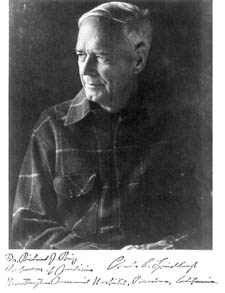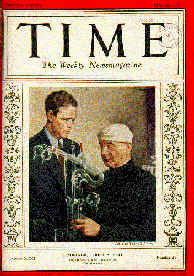
Famous solo flight to Paris
Practically everyone knows that Charles Lindbergh made the famous solo flight to Paris in 1929; he was born in Detroit on February 4, 1902, spent some of his youth in Little Falls, Minnesota, and was involved in the unsuccessful campaign for U.S. Senate by his father. Many are also aware of his barnstorming days, his self-imposed exile, his controversial participation in political movements, and finally his interest in environmental causes. Many also remember that he married Ann Morrow, the daughter of the American ambassador to Mexico and partner of J.P. Morgan. He died in Hawaii in 1974. For his aviation exploits, Charles Lindbergh was called the "Lone Eagle." His life, however, was not one of continuing triumphs. It was darkened by the horrible experience of the kidnapping and murder of his infant son. Involved in medical research
These facts are known to the general public. Few people, however, know that Lindbergh was also involved in medical research. This is why I met him and worked with him at the Rockefeller Institute in New York in 1936. I was a young physician, 27 years old, working at Carlsberg Biological Institute in Copenhagen, Denmark, to learn cell culture methods. There, I met both Lindbergh and Alexis Carrel, the surgeon. Both attended an international meeting of biology to demonstrate their new perfusion system. In setting up this apparatus, they needed someone who spoke both Danish and English, and luckily I was assigned the job. Carrel and Lindbergh planned to establish their perfusion system in Denmark, and I was chosen to learn their method in New York and return to Copenhagen where the perfusion system was to be installed. After several attempts, Carrel was able to obtain a Rockefeller stipend for me, and after some painful interviews with the Rockefeller people in Paris (the personnel at the Paris Headquarters of the Foundation had no concept of the Nazi menace), I traveled to New York, stopping in England to visit the Lindberghs in Seven Oaks, Kent. Working at the Rockefeller Institute
In America, working at the Rockefeller Institute (now Rockefeller University) in New York City, I had frequent contact with Charles Lindbergh. For him these frequent visits to Carrel's department at the Rockefeller Institute constituted an escape from the memory of the kidnapping and murder of his son. What brought Charles Lindbergh into biological research? The motivation was personal. Lindbergh's sister-in-law had rheumatic fever as a child and developed mitral stenosis. It was a protracted illness accompanied by hemoptysis, pulmonary edema, shortness of breath, fatigue. Apparently she was a vibrant, vital person, enjoying life, and fighting the illness that finally killed her.
Few of us today realize the tremendous advances that medicine has made in the last 50 years. In the field of cardiology, cardiopulmonary bypass has made possible surgery on the open, virtually bloodless heart. But at the time of Lindbergh's sister-in-law's illness, only inadequate medical therapy was available.
Lindbergh, who had an inquisitive mind, trying to apply mechanical solutions to technical problems, asked the question why surgery on the bloodless heart might not be possible. This idea was 20 years ahead of its time. He posed the question to his wife's anesthesiologist, who then directed him to Alexis Carrel, the Director of the Department of Experimental Surgery at the Rockefeller Institute in New York.
Carrel was known for his surgical technique. He was a Nobel Prize winner for his work on transplantation of organs, made possible by his technique of blood vessel suture. At the same time, Carrel was a seasoned research worker, who was not apt to indulge in fly-by-night projects. When Lindbergh approached him with his idea of operating on the bloodless heart to rescue his sister-in-law from certain death, Carrel was not overly enthusiastic, knowing that these techniques were still in the future. Instead, he suggested that Lindbergh participate with him in a study that was more to Carrel's taste, the culture of whole organs, a system to maintain an organ outside the body by circulating nutrient fluid through its artery; this would enable Carrel and Lindbergh to study the interplay between the circulating fluid and the perfused organ, using the latter as an indicator. Lindbergh's perfusion system was, in principle, a sterile glass container consisting of three chambers: organ, equalization, and pressure chambers. A flask filled with mineral oil under pulsatile pressure acted like the piston of a pump. Lindbergh's contribution was a perfusion system, which combined sterility with perfusion of a small organ at variable systolic and diastolic pressures and heart rate (frequency). Sterility was of major importance, since both Carrel and Lindbergh wanted to perfuse organs for several weeks, making possible the study of different perfusion fluids on the organ. Lindbergh accomplished this by his system of floating valves, making the whole apparatus a closed system by sealing it appropriately with airplane glue. The disadvantage in this system was the disproportionate volume of the perfusion fluid to the weight of the organ, frequently the cat's thyroid gland, and the lack of respiratory pigment, which would have carried oxygen to the perfused organ and made possible the use of larger organs. I tried to accomplish these goals later when I worked in the Department of Surgery at Columbia University, New York. Since hemoglobin in these perfusion systems is rapidly oxidized to nonoxygen-carrying pigments, I tried the respiratory pigment of the horseshoe crab, hemocyanin: when oxidized, it is a beautiful marine blue, and when reduced a pale white. Advanced the future of cardiac surgery
If Carrel had followed Lindbergh's suggestion to develop bypassing the heart during cardiac surgery, he could have advanced the future of cardiac surgery by many years. More than 20 years later, in 1954, thanks to the imagination and tenacity of another surgeon, Charles Gibbon, open heart surgery became a reality.4 Carrel's interest in the culture of whole organs was a natural extension of his work on cell cultures. The perfusion of whole organs was in line with Carrel's conceptual research. He saw it as a method of studying the interplay between the internal environment (the perfusion fluid) and the single organ, using the latter as an indicator. Because Carrel left the Institute soon afterward to begin his ill-fated and ill-advised journey to France during the Nazi occupation, neither he nor Lindbergh ever saw the fulfillment of the potentials of this technique. The method may become of considerable value in the study of the cultivation of viruses. The last time I saw Lindbergh
The last time I saw Lindbergh was when he visited me at the Huntington Memorial Hospital and Huntington Medical Research Institutes in Pasadena in 1970. He stayed at my house in La Canada. I am reprinting a letter he wrote me in 1970 after this visit, that shows how nostalgic he was at the memory of our joint stay at the Rockefeller Institute. It also shows that his excursion into the field of biomedical (cardiac) research was an experience he treasured all his life as a quiet period in a turbulent and disturbing past. This is his letter:


|
References:
- Ross WS: The Last Hero: Charles A. Lindbergh. New York: Harper & Row, 1968
- Bing RJ: Recollections of an eyewitness. Perspectives in Biology and Medicine 1996;39(2):227–238
- Berg AS: Lindbergh. NewYork: Penguin Putnam, Inc., 1998
- Bing RJ: John H. Gibbon, Jr.: Cardiopulmonary bypass--triumph of perseverance and character. Clin Cardiol 1994;17:456–457
Address for reprints:
Richard J. Bing, M.D.
Director, Experimental Cardiology
Huntington Medical Research Institutes
99 N. El Molino Avenue
Pasadena, CA 91101, USA
Reprinted with permission from Richard J. Bing, M.D. and the clinical-cardiology.org web site. This article can also be found on the Clinical Cardiology web site. Clin. Cardiol. 22, 494–495 (1999)
Privacy Policy | Terms and Conditions | This site is not affiliated with the Lindbergh family,
Lindbergh Foundation, or any other organization or group.
This site owned and operated by the Spirit of St. Louis 2 Project.
Email: webmaster@charleslindbergh.com
® Copyright 2014 CharlesLindbergh.com®, All rights reserved.
Help support this site, order your www.Amazon.com materials through this link.

